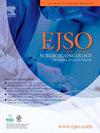Robot-assisted radical nephroureterectomy for locally advanced upper tract urothelial carcinoma: a multicenter study by the Junior ERUS/YAU Working Group on Robot-assisted Surgery
IF 2.9
2区 医学
Q2 ONCOLOGY
引用次数: 0
Abstract
Introduction
Aim of the study was investigate outcomes of patients affected by locally advanced (pT3-pT4 and/or pN+) upper tract urothelial carcinoma (UTUC) and treated with robot-assisted radical nephroureterectomy (RNU).
Materials and methods
Clinical and surgical data of newly-diagnosed UTUC patients referring to 9 high-volume centres from January 2019 to March 2023 undergoing RNU were collected.
Results
191 patients showed locally advanced disease. Da Vinci and Hugo RAS ™ System were employed in 95.8 % and 4.2 % of cases, respectively. Bladder cuff removal was carried out in 161 (84.3 %) patients, by using either an intravesical and extravesical approach in 50 (31.1 %) and 111 (68.9 %) respectively. Open and robotic approaches for bladder cuff removal were preferred in 107 (66.5 %) and 54 (33.5 %) patients, respectively. Lymph node dissection was performed in 55 % of patients. Median follow up was 19 (IQR 10–23) months and 31 (16.4 %) patients experienced bladder recurrence. On multivariate analysis, in those patients receiving RNU and bladder cuff removal, the approach for bladder cuff management (extravesical vs intravesical) was the only independent predictor of bladder recurrence (hazard ratio [HR]: 1.34; 95 % confidence interval [CI] 1.12–2.11; p = 0.03). Surgical approach for bladder cuff management (open vs robot) was not independently associated with bladder recurrence or tumor progression (both p > 0.05)
Conclusions
In experienced hands, the robotic approach showed satisfactory survival outcomes also for the surgical treatment of pathological locally advanced UTUC. Extravesical approach for bladder cuff management may be burdened by a higher risk for bladder recurrence in locally advanced disease.
机器人辅助根治性肾输尿管切除术治疗局部晚期上尿路上皮癌:一项由机器人辅助手术小组开展的多中心研究
本研究的目的是探讨局部晚期(pT3-pT4和/或pN+)上尿路上皮癌(UTUC)患者接受机器人辅助根治性肾输尿管切除术(RNU)治疗的结果。材料与方法收集2019年1月至2023年3月9个高容量中心的新诊断UTUC患者的临床和手术资料。结果191例患者出现局部进展。Da Vinci和Hugo RAS™系统分别占95.8%和4.2%。161例(84.3%)患者行膀胱袖移除术,其中50例(31.1%)和111例(68.9%)分别采用膀胱内和膀胱外入路。分别有107例(66.5%)和54例(33.5%)患者选择开放入路和机器人入路进行膀胱袖切除。55%的患者进行了淋巴结清扫。中位随访19个月(IQR 10-23), 31例(16.4%)患者膀胱复发。在多因素分析中,在接受RNU和膀胱袖带切除术的患者中,膀胱袖带处理方法(膀胱外vs膀胱内)是膀胱复发的唯一独立预测因素(风险比[HR]: 1.34; 95%可信区间[CI] 1.12-2.11; p = 0.03)。膀胱袖带手术入路(开放式与机器人)与膀胱复发或肿瘤进展无独立相关性(p > 0.05)。结论在经验丰富的患者中,机器人入路对于病理局部晚期UTUC的手术治疗也有令人满意的生存结果。膀胱袖外入路治疗局部晚期患者膀胱复发的风险较高。
本文章由计算机程序翻译,如有差异,请以英文原文为准。
求助全文
约1分钟内获得全文
求助全文
来源期刊

Ejso
医学-外科
CiteScore
6.40
自引率
2.60%
发文量
1148
审稿时长
41 days
期刊介绍:
JSO - European Journal of Surgical Oncology ("the Journal of Cancer Surgery") is the Official Journal of the European Society of Surgical Oncology and BASO ~ the Association for Cancer Surgery.
The EJSO aims to advance surgical oncology research and practice through the publication of original research articles, review articles, editorials, debates and correspondence.
 求助内容:
求助内容: 应助结果提醒方式:
应助结果提醒方式:


